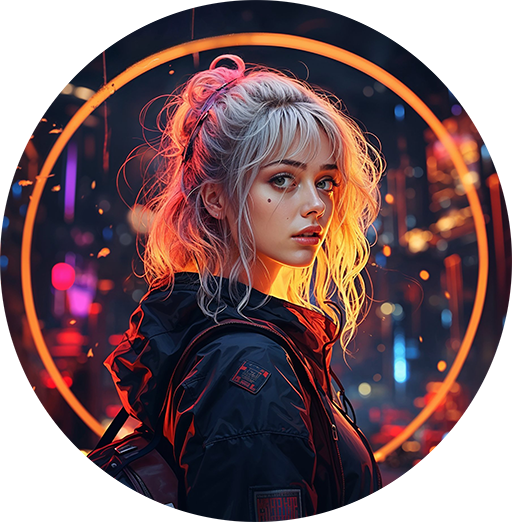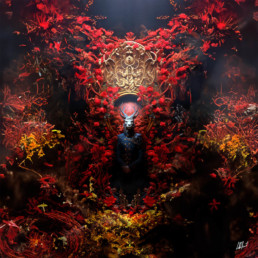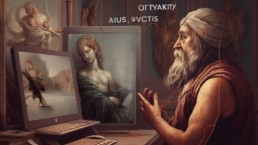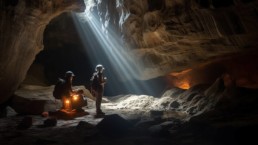From Algorithms to Art: Exploring the Role of AI in the Creative Process
Artificial Intelligence (AI) has rapidly evolved from being a futuristic concept to a reality that is now integrated into our daily lives. From voice assistants like Siri and Alexa to self-driving cars, AI has revolutionized the way we live and work. However, its impact on the creative industry has been a topic of debate. Can AI really be creative? Or is it just a tool to assist human creativity? In this article, we will explore the role of AI in the creative process and how it is changing the way we approach art and design. We will delve into the ways in which algorithms are being used to create music, generate art and even write novels. We will also examine the ethical implications of using AI in the creative industry and whether it will replace human creativity altogether. So, let’s dive into the world of AI and discover how it is transforming the way we create and appreciate art.
Understanding algorithms and their role in creativity
To understand the role of AI in the creative process, we must first understand algorithms. An algorithm is a set of rules or instructions that are used to solve a problem or accomplish a task. In the context of AI, algorithms are used to process vast amounts of data and make predictions based on patterns and trends. This is particularly useful in the creative industry, where algorithms can be used to generate new ideas, refine existing ones, and even create entirely new works of art.
Algorithms can be used in a wide variety of ways in the creative process. For example, they can be used to analyze data on consumer preferences and trends to inform the design of new products. They can also be used to generate music, artwork, and even literature. By analyzing patterns and trends in existing works, algorithms can create new works that are similar in style and genre.
Despite the potential benefits of using algorithms in the creative process, there are also concerns about their impact on human creativity. Some argue that relying too heavily on algorithms and data analysis can stifle creativity and limit the potential for truly groundbreaking works of art. Others argue that algorithms are simply tools that can be used to enhance the creative process, rather than replace it entirely.
The benefits of AI in the creative process
Despite the concerns, there are also many potential benefits to using AI in the creative process. One of the main benefits is the ability to process vast amounts of data quickly and efficiently. This can be particularly useful in fields like product design, where designers can use data analysis to inform their decisions and create products that are more likely to be successful.
By analyzing patterns and trends in existing works, algorithms can identify new areas for exploration and generate new ideas that might not have been considered otherwise.
Another potential benefit of using AI in the creative process is the ability to generate new ideas and inspiration. By analyzing patterns and trends in existing works, algorithms can identify new areas for exploration and generate new ideas that might not have been considered otherwise. This can be particularly useful in fields like music and literature, where new ideas and inspiration are essential for creating innovative and compelling works.
AI can also be used to enhance collaboration and communication in the creative process. For example, designers and artists can use AI-powered tools to share ideas and collaborate on projects in real-time, regardless of their physical location. This can help to break down barriers and facilitate more effective collaboration between individuals and teams.
Case studies on AI in the creative industry
There are many examples of AI being used in the creative industry to create new works of art and design. One example is the use of machine learning algorithms to generate new music. By analyzing patterns and trends in existing music, algorithms can create new compositions that are similar in style and genre. This can be particularly useful for generating background music for videos, games, and other applications.
Another example of AI being used in the creative industry is the use of generative adversarial networks (GANs) to generate new artwork. GANs are a type of machine learning algorithm that can be used to generate new images based on existing ones. By analyzing patterns and trends in existing artwork, GANs can create new works that are similar in style and genre. This can be particularly useful for creating new designs for products and marketing materials.
AI is also being used in the writing industry to generate new works of literature. For example, OpenAI recently released GPT-3, a language model that can generate human-like text. While the technology is still in its early stages, it has already been used to generate short stories, poetry, and even entire articles.
The ethical implications of AI in creativity
Despite the potential benefits of using AI in the creative process, there are also many ethical implications to consider. One of the main concerns is the potential for bias in the algorithms used to generate new works of art and design. If the algorithms are trained on a limited dataset, they may produce works that are biased towards certain groups or perspectives.
Another concern is the potential for AI to replace human creativity altogether. While AI can be used to generate new works of art and design, it is still limited in its ability to create truly innovative and groundbreaking works. Some argue that relying too heavily on AI could lead to a homogenization of creative works and limit the potential for true innovation.
There are also concerns about the impact of AI on job security in the creative industry. As AI becomes more advanced, it may be able to perform tasks that were previously done by human workers. This could lead to job losses and a shift in the way the creative industry operates.
The future of AI in the creative industry
Despite the concerns about the impact of AI on the creative industry, there is no doubt that it will continue to play an increasingly important role in the years to come. As AI technology continues to evolve, we can expect to see new and innovative applications of AI in the creative process.
One potential area of growth is in the use of AI to enhance virtual reality and augmented reality experiences. By using AI-powered tools to create more realistic and immersive environments, designers and artists can create new and exciting experiences for consumers.
Another potential area of growth is in the use of AI to personalize creative works for individual consumers. By analyzing data on consumer preferences and behavior, AI algorithms can create customized works of art and design that are tailored to the individual’s tastes and preferences.
Tools and software for AI-assisted creativity
As the use of AI in the creative industry continues to grow, so too do the number of tools and software available to assist with the creative process. One example is Canva, a graphic design tool that uses AI-powered algorithms to help users create professional-looking designs quickly and easily.
Another example is Amper Music, a tool that uses AI to generate new music tracks. Users can specify the genre, mood, and tempo of the music they want to create, and the algorithm will generate a new track that meets those specifications.
There are also a growing number of software tools available that use AI to enhance the capabilities of existing creative tools. For example, Adobe recently released an AI-powered tool called Sensei that can be used to automate tasks and enhance the capabilities of its existing design tools.
Limitations and challenges of AI in creativity
While there are many potential benefits to using AI in the creative process, there are also many limitations and challenges to consider. One of the main challenges is the need for large amounts of data to train the algorithms used in AI-powered creative tools. This can be particularly challenging in fields like music and literature, where there may be limited data available.
Another challenge is the potential for bias in the algorithms used to generate new works of art and design. If the algorithms are trained on a limited dataset, they may produce works that are biased towards certain groups or perspectives.
Finally, there is the challenge of integrating AI tools into existing creative workflows. While AI can be a powerful tool for enhancing the creative process, it can also be complex and difficult to integrate into existing workflows.
The human touch in the creative process
Despite the potential for AI to transform the creative industry, it is important to remember that the human touch is still essential for creating truly innovative and compelling works of art. While AI can be a useful tool for generating new ideas and refining existing ones, it is still limited in its ability to create truly groundbreaking works.
Ultimately, the most successful creative works will be those that are created through a combination of human creativity and AI-powered tools. By using AI to enhance the creative process, designers and artists can create new and exciting works that push the boundaries of what is possible.
Conclusion
In conclusion, AI is transforming the way we approach art and design. From generating music and artwork to writing novels, AI is playing an increasingly important role in the creative process. While there are many potential benefits to using AI in the creative industry, there are also many ethical implications and challenges to consider. As AI technology continues to evolve, it is important to strike a balance between the use of AI-powered tools and the essential human touch that is needed to create truly innovative and compelling works of art.
Digital Art: Debunking Myths
In recent years, digital art has become increasingly popular, yet it is still surrounded by numerous misconceptions and questions. As artists explore the fusion of art and artificial intelligence, it is essential to clarify the meaning of digital art, address common concerns, and emphasize its value in today’s creative landscape.
Understanding Digital Art
Digital art refers to any form of artistic expression that uses digital technology as an integral part of the creation, manipulation, or presentation process. It encompasses various styles and techniques, ranging from digital painting and illustration to photography, 3D modeling, and interactive installations.
Debunking Myths and Addressing Concerns
Digital art is real art: Some argue that digital art is not “real art” because it does not involve traditional mediums like paint, canvas, or sculpting materials. However, digital art is simply another medium that allows artists to express their creativity and emotions, just like traditional art forms.
Digital art isn’t inherently better or worse: The quality of an artwork depends on the artist’s skill and creative vision, regardless of the medium used. While digital tools may offer convenience and efficiency, traditional art techniques have their own unique charm and tactile qualities.
Digital art is not cheating: The use of digital tools does not automatically make art creation easier or less authentic. Digital artists still need to develop their skills, hone their craft, and invest time and effort into their work.
Exploring the World of Digital Art
Where to find digital art: Digital art can be found in various places, such as online galleries, social media platforms, digital museums, and even physical exhibitions showcasing digital prints or interactive installations.
The future of traditional and digital art: While digital art continues to grow in popularity, it is unlikely to replace traditional art completely. Both forms of art have their own distinct value and appeal, and the two can coexist, enriching the overall creative landscape.
Protecting digital art: Digital art can indeed be copyrighted. Just like traditional art, digital creations are protected by intellectual property laws, allowing artists to safeguard their work from unauthorized use or reproduction.
Digital art is a diverse and fascinating realm that offers new opportunities for artists to explore and express their creativity. By understanding its true potential and addressing common misconceptions, artists can embrace digital art as a valuable and legitimate form of artistic expression.
Art-AI: Exploring the Uses of ChatGPT
As the intersection between art and artificial intelligence continues to evolve, ChatGPT emerges as a revolutionary AI language model that offers countless possibilities for creative minds. With its advanced capabilities, artists and individuals in the creative field can leverage the power of ChatGPT to elevate their work, streamline their processes, and unleash their full artistic potential.
Understanding ChatGPT
ChatGPT, developed by OpenAI, is a highly advanced language model based on the GPT-4 architecture, which utilizes reinforcement learning from human feedback (RLHF) for continuous improvement. This state-of-the-art technology allows ChatGPT to comprehend, generate, and engage in conversational dialogue, making it an invaluable tool for various applications across diverse industries, including the realm of art and creativity.
Expanding the Possibilities for Artists
- Enhanced Virtual Assistants: ChatGPT can be integrated into virtual assistants such as Siri, Alexa, or Google Assistant to offer more personalized and creative suggestions for artists. It can help with tasks like recommending color palettes, finding inspiration for new projects, or suggesting relevant art events and exhibitions.
- Improved Search Functionality: As a search engine tool, ChatGPT can provide artists with more intuitive, natural language-focused search results. This allows artists to explore art-related information, discover new techniques, and find resources for their projects more efficiently and effectively.
- Creative Content Generation: ChatGPT’s remarkable language generation capabilities enable it to craft engaging content such as blog posts, social media captions, and even descriptions for art pieces. This can help artists save time, generate ideas, and maintain a consistent online presence.
- Collaborative Artwork: Artists can harness ChatGPT’s language capabilities to create collaborative pieces, such as poetry or written narratives, that complement their visual art. The AI model can be used to develop unique stories or concepts, sparking new ideas and expanding the creative process.
- Educational Support: ChatGPT can be utilized as an educational tool, assisting artists in learning new techniques, understanding complex concepts, or exploring the history of art. With its ability to adapt and rephrase explanations based on user feedback, ChatGPT makes learning more engaging and personalized.
- Multilingual Assistance: ChatGPT’s proficiency in multiple languages enables artists to access a broader range of resources, translate their work for global audiences, or collaborate with international peers, thereby breaking down language barriers and expanding creative horizons.
- Coding Support: For artists working with digital mediums or exploring generative art, ChatGPT can provide assistance in writing and debugging code, analyzing security flaws, and crafting proof-of-concept demos. This support helps artists streamline their creative process and focus on the artistic aspects of their work.
ChatGPT’s versatility and advanced language capabilities open up a world of opportunities for artists in the realm of artificial intelligence. By leveraging ChatGPT’s potential, creative minds can revolutionize their art, engage with technology in unprecedented ways, and push the boundaries of human imagination.
AI-Driven Art Collaborations: When Creativity Meets Technology
Learn about groundbreaking collaborations between artists and AI developers that showcase the fusion of human creativity with advanced AI systems.
Art has always been a powerful means of expression, transcending time, and connecting individuals from diverse cultures. As technology continues to evolve, the creative landscape is undergoing a transformation, with artificial intelligence (AI) taking center stage. In this blog post, we’ll explore some of the most innovative AI-driven art collaborations that are redefining the boundaries of creativity and showcasing the incredible potential of merging human ingenuity with advanced AI systems.
The Next Rembrandt Project
The Next Rembrandt Project is a fascinating collaboration between data scientists, engineers, and art historians. By analyzing the works of the Dutch master Rembrandt, the team developed an AI algorithm capable of generating a new painting that mimics his style. The result was an impressive AI-generated portrait that captured the essence of Rembrandt’s artistic brilliance, demonstrating the potential of AI-driven art to pay homage to the greats while pushing the boundaries of creativity.
AICAN: AI-Assisted Abstract Art
AICAN is an AI-driven art project developed by Rutgers University’s Art and Artificial Intelligence Lab. The AI system was trained on thousands of pieces of abstract art and then tasked with creating its own unique pieces. In collaboration with human artists, AICAN’s output has been showcased in numerous exhibitions, demonstrating the remarkable synergy between human creativity and AI-generated art.
Google’s DeepDream: A Psychedelic Journey
Google’s DeepDream is an AI project that has captured the imagination of artists worldwide. By using neural networks to analyze and reinterpret images, DeepDream generates surreal and dreamlike visuals that have inspired countless collaborative projects. Artists have used DeepDream’s unique output to create otherworldly works of art, blending human creativity with the power of AI to push the boundaries of artistic expression.
Obvious Art’s AI-Generated Portraits
Obvious Art, a French art collective, has made headlines with its AI-generated portraits, which have even been auctioned off at prestigious art events. By training their AI model on historical portraits, the team successfully generated strikingly original artworks that challenge our understanding of what constitutes art. These AI-driven creations highlight the incredible potential of blending human artistic vision with AI technology.
The Art and Artificial Intelligence Festival In Leicester
The Art-AI is an annual event that celebrates the intersection of art, technology, and AI. Artists and developers from around the world come together to showcase their innovative projects, demonstrating the remarkable collaborations that result when human creativity meets AI-driven technology. The festival provides a platform for exploration and discussion, inspiring future generations of artists to embrace the power of AI in their work.
As AI continues to advance, the possibilities for AI-driven art collaborations are virtually limitless. These groundbreaking projects demonstrate the power of merging human creativity with advanced AI systems, resulting in a new form of artistic expression that is both innovative and awe-inspiring. By embracing the fusion of technology and art, we can expand our understanding of creativity and unlock new realms of artistic potential.
Ethics and Copyright in AI-Generated Art
Explore the challenges and implications of copyright and ownership in the realm of AI-generated art, and how artists and organizations can protect their creations.
AI systems learn from vast amounts of data, including copyrighted material, there is a risk that these systems might generate art that too closely resembles pre-existing works.
As AI-generated art becomes increasingly popular, artists and organizations face new challenges in navigating the legal landscape surrounding copyright and ownership. This growing field raises ethical questions and implications that are essential to address to ensure the protection of both human creators and AI-generated works.
One of the primary concerns in AI-generated art is determining the ownership of the final piece. Traditionally, copyright law awards ownership to the creator of a work. However, in the case of AI-generated art, it is unclear whether the artist who provides the input, the AI developer, or even the AI itself should be considered the creator.
Another challenge lies in the potential for AI-generated art to inadvertently infringe upon existing copyrights. As AI systems learn from vast amounts of data, including copyrighted material, there is a risk that these systems might generate art that too closely resembles pre-existing works. This issue highlights the importance of developing methods to ensure that AI-generated art remains original and does not violate copyright laws.
To navigate these challenges, artists and organizations need to stay informed about the latest developments in copyright law and consider implementing agreements that clearly outline the rights and responsibilities of all parties involved. This may include contracts between artists and AI developers, ensuring that the ownership of AI-generated works is clearly defined.
Additionally, artists should consider registering their AI-generated works with copyright offices to establish a legal record of their creations. This process can help protect artists from potential infringement claims and provide a basis for legal action should disputes arise.
As AI-generated art continues to evolve, it is crucial for artists and organizations to stay informed about the changing legal landscape and take steps to protect their work. By understanding the challenges and implications of copyright in this burgeoning field, artists can confidently create and share their AI-generated masterpieces.










